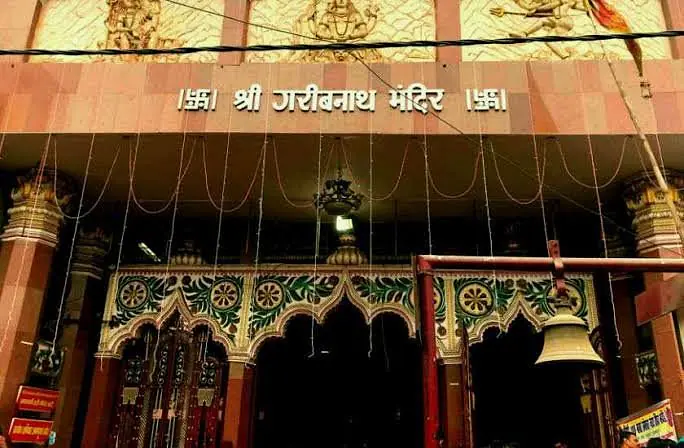
Nestled in the heart of Muzaffarpur, Bihar, Garibnath Mandir (also known as Baba Garib Nath Dham) stands as a testament to faith, legend, and communal harmony. Revered as one of the most important Shiva temples in Bihar and fondly called the “Deoghar of Bihar,” the temple is a vibrant center of devotion, astonishing history, and rich tradition
Historical Roots and Origins
The history of Garibnath Mandir dates back nearly three centuries. Local lore and religious accounts agree that the temple’s origin is linked to a miraculous and poignant tale. The land where the temple now stands was once a forest area dotted with peepal and banyan trees
According to the most popular legend, the site originally belonged to a poor man who, under economic duress, sold his land to a local landlord. When attempts were made to cut down the ancient banyan tree on the newly acquired land, workers witnessed a startling phenomenon—bloodlike liquid began to ooze from the trunk. Disturbed, the work halted, and that very night, the landlord reportedly dreamed of Lord Shiva, who instructed him to consecrate the site for worship. Shiva revealed that He had manifested Himself there, and since a destitute man had discovered Him, He would remain enshrined in that form as “Garib Nath”—the Lord of the Needy
This miraculous event marked the beginning of the temple’s revered history. Worship of the Shivlinga (the aniconic representation of Shiva) began, and the fame of Garibnath spread, drawing devotees from far and wide.
Spiritual Significance & Devotional Practices
Garibnath Mandir is dedicated to Lord Shiva, but unlike many other shrines, it is known for fulfilling the heartfelt wishes of those who pray with true devotion. Over the centuries, countless stories of answered prayers and miraculous blessings have deepened its spiritual aura, strengthening people’s faith even more
The temple complex houses not just the Shivlinga but several subsidiary shrines, including sanctums dedicated to Lord Surya, Radha-Krishna, and Hanuman. At the entrance of the sanctum sanctorum sits Nandi, the revered bull, facing his Lord, Shiva
Festivals, Rituals, and Celebrations
The temple comes alive during the auspicious Hindu month of Shravan (July–August), when devotees throng to offer holy water from the Ganges, carried over 70km from Sultanganj. During this period, particularly on Mondays, a sea of saffron-clad Kanwariyas line up for hours to perform ‘Jalabhishek’ (anointment of the Shivlinga), believing prayers during Sawan hold special potency
Important festivals celebrated here include:
- Shravani Mela: The biggest event, marked by massive pilgrimages and elaborate rituals.
- Mahashivratri: Marked with midnight vigils, fasting, and vibrant processions.
- Holi: Unique to this temple, Holi is celebrated with Abir and Gulal offered to Lord Shiva before the festivities begin in the city, a tradition believed to bring prosperity and communal harmony
Other Observances: Special rituals such as the early morning ‘Bhasmarti’ (offering of ashes) add depth to daily worship, drawing spiritual seekers seeking rare experiences
Architecture and Atmosphere
Garibnath Mandir reflects traditional North Indian temple architecture. The main temple, with its ornate spires and sturdy stonework, radiates a calming spirituality despite the crowds. The sanctum enshrines the naturally emerged Shivlinga, and the premises echo with ancient hymns and the ringing of bells. The surrounding temple courtyard, with age-old banyan and peepal trees, adds to its tranquil, sacred ambiance
The temple’s location, near the bustling Purani Bazar, makes it accessible and central, yet stepping inside the complex, one experiences peace and sanctity amid the city’s hustle.
Legends and Local Belief
Beyond its founding legend, several enchanting tales surround Garibnath Mandir. One tale speaks of a poor devotee distressed over his daughter’s marriage arrangements. After praying at the temple, he is said to have found all wedding needs miraculously met on returning home, further cementing faith in the temple’s benevolence
Another unique tradition recounts a serpent that appears during morning aarti, hanging from the sacred fig until prayers conclude—a sign of divine presence for many regulars
Iconic Symbolism and Modern Relevance
The local government and citizens of Muzaffarpur have moved to celebrate the temple’s historical roots by planning the installation of iconic statues—specifically, a large iron banyan tree near Motijheel Bridge and a litchi monument at Laxmi Chowk, linking the city’s spiritual heritage with its famed agricultural bounty
Efforts like these are designed to preserve the legacy and relay the origin stories of Garibnath Mandir to younger generations, ensuring that the city’s culture and religious values remain vibrant and visible for decades to come.
Management and Pilgrim Facilities
Managed today by the Bihar State Religious Shrine Board, the temple offers organized crowd control, especially during peak festivals when pilgrim numbers swell into the thousands. Modern security measures and facilities have improved convenience and safety for all visitors
Within the precincts, devotees perform numerous lifecycle rituals, including Mundan (first hair-cutting), Janeu (sacred thread ceremonies), and marriage pujas, reflecting the temple’s pivotal role in the community
Visiting Garibnath Mandir
Garibnath Mandir is easily accessible from the Muzaffarpur railway station and main bus stands. It remains a welcoming space, inviting both residents and travelers to experience its history, rituals, and atmosphere. The temple is open year-round, but the periods of Shravan and major festivals provide the most kaleidoscopic experience of faith in action
Garibnath Mandir continues to stand, not only as an architectural and religious marvel but as a living embodiment of hope, community, and divine presence in Muzaffarpur. Whether observed in the riotous colors of Holi, the devotional fervor of Sawan, or the daily rhythms of prayer, the temple remains the beating heart of the city’s spiritual life—an eternal sanctuary for anyone seeking solace, blessings, and a touch of the miraculous.
